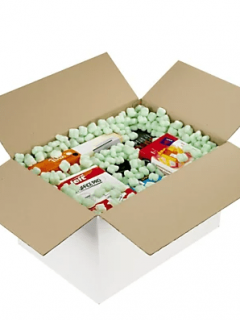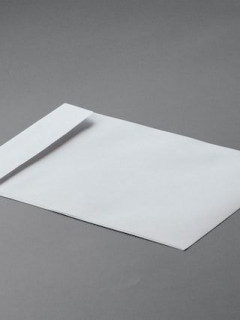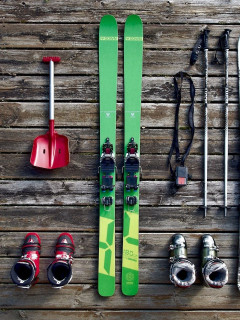Many courier companies in Poland treat food as a product excluded from transport. This is mainly due to the need to maintain optimal conditions of temperature, humidity and sunlight during transit. It is possible to send food by courier, but at your own risk and with appropriate protection of the goods. Find out how to send food by courier.
Shipping food – can it be done?
Legal food transit is carried out by freight forwarding companies exclusively engaged in the transportation of food. This, of course, does not mean that sending food by courier by private individuals is impossible. It can be done as much as possible, although the carriers usually indicate that they will not be able to guarantee optimal conditions for the transit of such goods.
Sending food in parcels by standard transport services involves a considerable risk of leaks or spoilage. This is particularly common if the sender does not take care to adequately protect the goods during transit. When deciding to send a parcel of food by standard courier services, make sure you have the cardboard box needed for safe shipment of such goods.
In this case, isothermal packaging works well. They are able to maintain temperatures between 2 and 8 degrees Celsius for up to more than 24 hours. By enclosing food products in such a carton, you increase the chances that the food will reach the recipient fresh and even still cool.
How to send a food parcel? Step-by-step guide
It is generally advised against sending home-cooked meals, meat and processed foods by courier. This is only for safety reasons, so that the goods do not spoil if transit is delayed. Food items that you can safely send are mainly dry food and canned food with a long expiry date. Such items are rather rarely damaged, especially if they are correctly packed in cartons.
We highlight a few steps on how to send food by courier so that the food reaches the recipient intact and fully fresh.
- Choose secure cardboard or isothermal packaging.
- Fill the bottom of the package with bubble wrap or other cushioning filler.
- Place the food in the sealed boxes and insert into the cardboard packaging.
- Cover the goods with an additional layer of filler.
- Close the parcel with parcel tape.
- Mark the carton with warning or information stickers, e.g. the required transport temperature.
- Print out the waybill, stick it on and hand over the consignment to the courier.
To send food safely by courier, it is a good idea to have a contract for the transit of food goods at lower temperatures. This increases the chances of products reaching the recipient without the risk of spoilage. Check out our guide to warning stickers for parcels. You’ll find out how to label your food parcel.
Packing materials useful for sending food by courier
There really are a lot of operational materials that can be used when shipping food. A good choice is 5-ply corrugated cardboard boxes. They are thick enough so that they do not get wet, plus they protect food from impact during transport.
Here are some of the operational materials needed for packing and shipping food by courier.
- Shipping cut cartons – these are ideal for packing small food items, such as dried fruit. They can be easily closed and opened and are also suitable for stacking. So you can easily use them for bulk shipping of food on pallets.
- Specialised organic cartons – these are suitable for shipping all kinds of goods, including foodstuffs. You can enclose dry food or such in canned form.
- Moisture absorber sachets – these are a must, especially when shipping fresh food such as salad, sandwiches or ready-made lunches. The less moisture in the parcel, the less risk of food spoiling.
- Bags and pouches for packaging – you can use recycled plastic or string bags, which are great for sealing certain foods, such as fruit. Once the product is in the bag, you can arrange it safely in the carton between layers of filler.
- Kraft wrapping paper – this is essential for safely packaging food products. Shipping food using kraft paper is much safer, plus it is 100% environmentally friendly.
There are many more materials that are useful when shipping food. All you need to do is carefully browse through RAJA’s offer and choose accessories and cartons that are perfectly suited to the dimensions of the goods you are transporting. How do I send food by courier so that it is 100% safe? The best way is to use isothermal cartons, which maintain lower temperatures inside a closed box for up to several dozen hours.
Sending food by courier – what products can be sent and what should be avoided?
Before you prepare a parcel of food to be sent by courier, make sure that the goods have any chance of arriving intact. We divide food products into three categories based on their ability to be transported safely.
Food products safe for courier transport
This category includes products packaged in metal tins with a long shelf life, dry food, sweets, chips, coffees and teas. Sending food by courier is also safe for loose and dry products, such as flour. However, it is worth remembering to ensure the right conditions of carriage, e.g. low humidity levels inside the parcel.
Food products whose shipment may be problematic
This group of products includes all kinds of cold cuts packed hermetically in meat processing plants. These most often need to be consumed within 14 days of packaging, allowing for relatively safe food shipping. Juices, purees and preserves in glass containers can also be sent by courier, but only if you take care to secure the carton properly.
Food products that cause transport problems
Ice, all kinds of cooling pads, glass bottles of alcohol and products with a short shelf life are goods that you should avoid sending by courier. For example: if you are already sending sauces in plastic tubes or glass containers with food – you must not only properly secure the package, but also ensure that the transport temperature is optimal and that the shipping company has the shortest possible lead time.
How do I send food by courier? The most important information in a nutshell
Tips on how to send food by courier are plentiful. All you need to do is use a few tried and tested methods and your food products will arrive fresh and intact. Some tried-and-tested tips are presented below:
- wrap bottles and glass jars in bubble wrap or polythene film.
- seal loose products in ziplock bags with a tight seal,
- protect easily damaged food with parcel filler and place in separate cardboard packaging,
- ensure the cushioning of the package from the bottom, side and top,
- wrap the finished package in stretch foil – this ensures that even if liquid spills out, the package will not be completely damaged.
Can you send food by post or courier? Of course you can! Companies carrying out such transit in bulk quantities usually use a modern fleet of refrigerated vehicles, so that the food remains fresh for up to several dozen hours of ongoing transit. Shipping food yourself by courier is also possible, although it requires proper preparation. Good planning of the shipment (preferably outside the weekend), as well as the use of professional food packaging materials , are essential.














